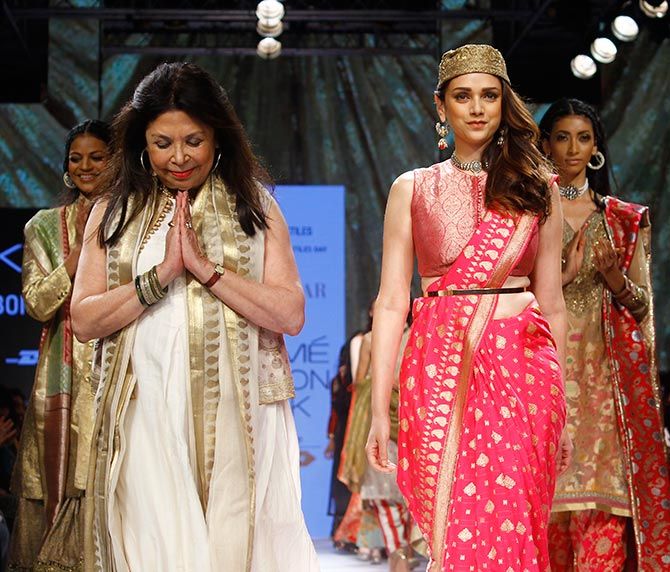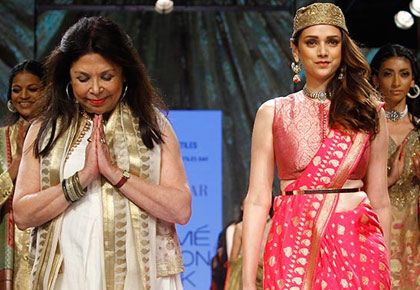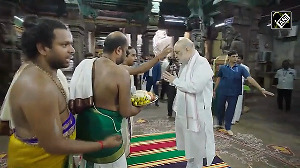Designer and revivalist Ritu Kumar shares with the public her personal collection of textiles from her travels, as well as reflections and commentary. Ritika Kochhar reports.
Also read: 50 years of Ritu Kumar

Photograph: Hitesh Harisinghani/Rediff.com
Ritu Kumar has built a huge cave of textiles inside the Visual Art Gallery at Delhi's India Habitat Centre.
The walls gleam with digital prints of ancient textile patterns that have inspired her journey as a revivalist and fashion designer over the past 50 years.
When you peer closely at the prints, you realise that each is made up of many old designs sourced by Kumar from textile centres across India and Asia. The prints include the classic blue hexagonal star from the mosques of Uzbekistan as well as collages from Odisha, Andhra Pradesh, Gujarat, Varanasi, Bhutan etc.
The pride of place, opposite the entrance, belongs to a huge Srikalahasti Kalamkari piece.
On closer look, you realise that the cloth walls are a background for paintings and textiles.
The first painted collages show murals from the Ajanta Caves (2nd-5th century BCE) and Chaurapanschasika paintings (12th-15th century CE). They offer proof that several textile patterns that we sport so thoughtlessly today, including ikat and bandhini, have an ancient provenance.
The Uzbeki series includes the bazaar, the mud huts where some of the most renowned textiles in the world are created and an image of Babar -- the founder of the Mughal Empire in India and a man forgotten in his own country.
There's an image of Kumar's favourite block printer, Dipakar, and of Beliaghata in West Bengal, where the first workshop she attended on textiles was held.
The textiles are sourced from Kumar's own vast collection and include ancient robes that she brought back from her travels in Uzbekistan, Bhutan and Myanmar.
Kumar's exhibition centres on a series of travelogues on her travels through textile centres such as Kashmir, Varanasi, Bengal, Tamil Nadu, Masulipatnam, Goa, Maharashtra, Gujarat, Rajasthan, Bhutan and Myanmar.
"I think this is the first time that an Indian designer has shared with the public her personal writings by way of a travelogue, and that too in the form of an exhibition. We have chosen to present excerpts from her personal diaries and this gives a personal and intimate insight into Mrs Kumar's work, in contrast to her work in the public domain," says Mayank Mansingh Kaul, curator of this exhibition.
Kumar's first travelogue, which is being released along with the show, focuses on her travels through Uzbekistan. The rest of the publications will also be launched this year.
While they reflect her research and reflection on the textile arts of the regions and their unique histories, they are also meant to help people navigate these relatively unknown places -- there's commentary on everything from the flora and fauna, food, where to stay and whom to get in touch with these to ease your travels.
Kumar's background as an art historian and artist also play a big role in the book and exhibition.
Along with pages from the books, the exhibition also displays archival textiles, vintage photographs, collages and paintings. The paintings even include pictures of the flowers that grow in these regions and their seasons.
Kumar wants these contemporary travelogues to be light bedtime reading.
Thus, the travelogues help offer a personal perspective on the ever-changing field of textiles, show the interconnections between distant cultures that have ancient shared artistic heritages and tell the story of handcrafted traditions at the crossroads of change in India. For example, old family portraits in a photographer's studio in Bukhara provided the missing link between hand-block printing, ikat and zardozi.
The name of the exhibition, "Crossroads", displays her concern for the status of handloom and workers in India, a subject that Kumar has spoken on often.
"Eighteen million people in India earn a daily livelihood from the handloom industry. We are at a crossroads right now because of commercial reasons. People do not want to work in the handloom industry, even those who are highly skilled. It would be a terrible pity if people left. Nowhere in the world do they have this breadth of textiles. It requires a huge amount of sensitivity and understanding from people in the fashion world and those in the government to ensure that they continue."
Her predominant response to her trip to Uzbekistan was melancholy.
"I felt sad that they've lost their traditions, and we're going the same way."
In conversation with Ritu Kumar: 'India never goes out of fashion'












